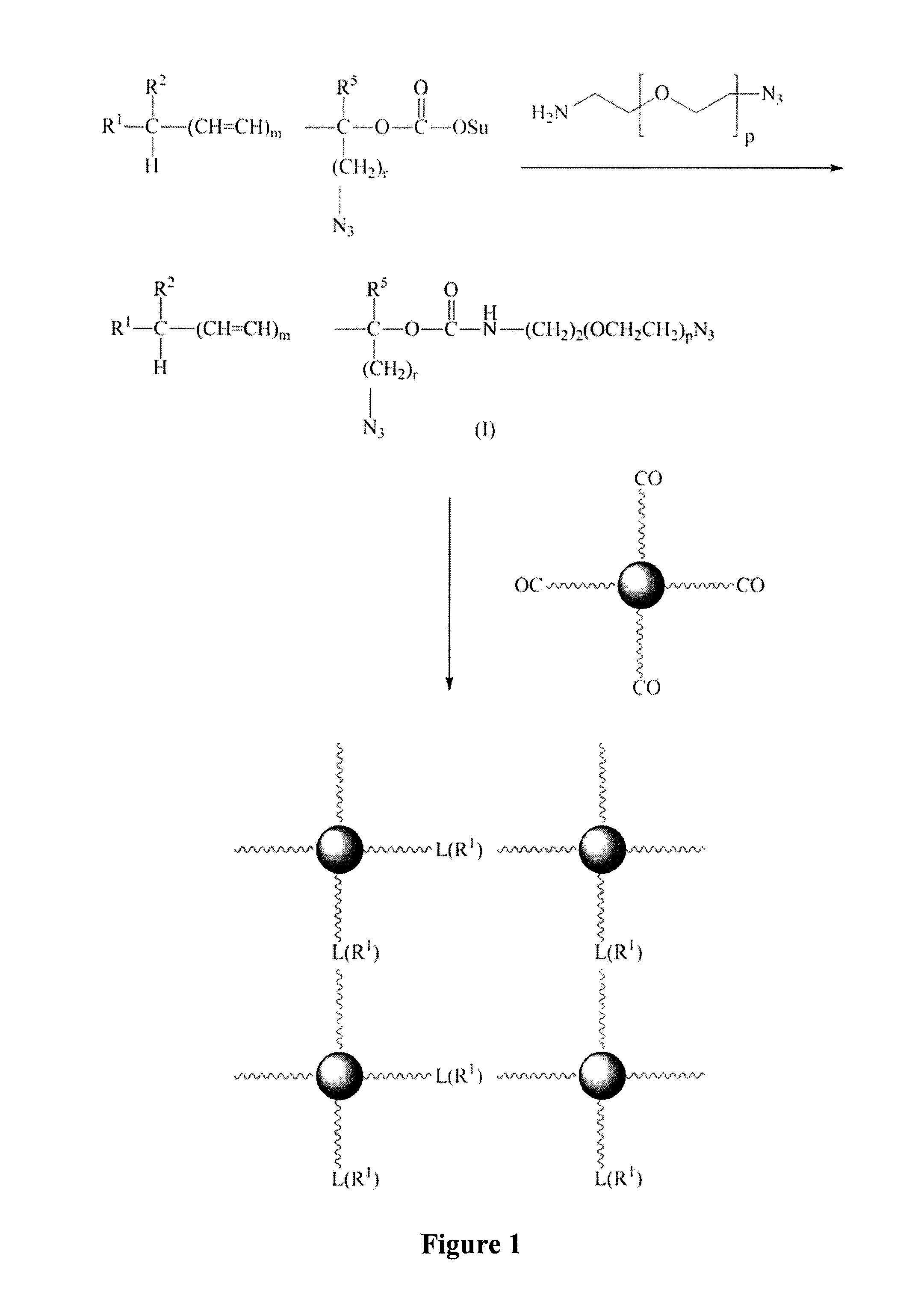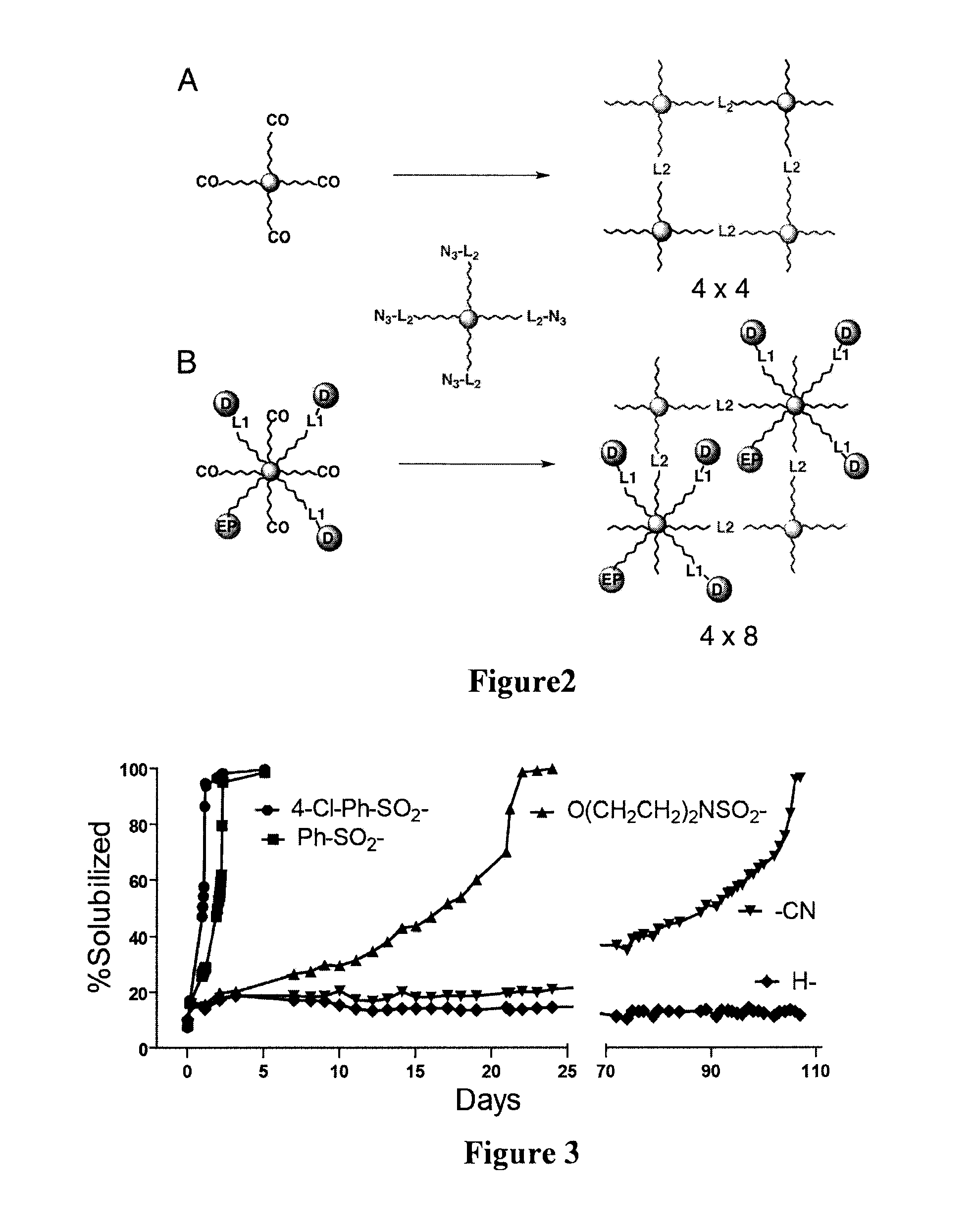Hydrogels with biodegradable crosslinking
a crosslinking and biodegradable technology, applied in the field of hydrogels with biodegradable crosslinking, can solve the problems of inter-patient variability, uncontrollable degradation and thus unpredictable degradation, and painful surgical removal of spent hydrogel carriers
- Summary
- Abstract
- Description
- Claims
- Application Information
AI Technical Summary
Benefits of technology
Problems solved by technology
Method used
Image
Examples
example 1
Preparation of 6-Azidohexanal
[0154]
[0155](1) 6-Azido-1-hexanol: a mixture of 6-chloro-1-hexanol (25 g, 183 mmol) and sodium azide (32.5 g, 500 mmol) in 200 mL of water was heated at reflux for 20 h, then cooled to ambient temperature and extracted 3× with ethyl acetate. The combined extracts were washed with brine, dried over MgSO4, filtered, and concentrated to yield the product as a pale yellow oil (28.3 g).
[0156](2) 6-Azidohexanal: Solid trichloroisocyanuric acid (4.3 g) was added in small portions to a vigorously stirred mixture of 6-azido-1-hexanol (7.15 g), TEMPO (50 mg), and sodium bicarbonate (5.0 g) in dichloromethane (100 mL) and water (10 mL). The mixture was stirred for an additional 30 minutes after addition, then filtered through a pad of Celite. The organic phase was separated and washed successively with sat. aq. NaHCO3 and brine, then dried over MgSO4, filtered, and concentrated to provide the product (5.8 g), which was used without further purification.
example 2
Preparation of ω-Azido-PEG-Aldehydes
[0157]
[0158]Solid trichloroisocyanuric acid (60 mg) was added to a vigorously stirred mixture of O-(2-azidoethyl)heptaethylene glycol (n=7; 250 mg), 1 mg of TEMPO, 100 mg of NaHCO3, 2 mL of CH2Cl2, and 0.2 mL of water. The mixture turned orange, and after approximately 30 minutes a white suspension was formed. TLC analysis (1:1 acetone / hexane) indicated formation of a product that stained with phosphomolybdic acid. The mixture was diluted with 10 mL of CH2Cl2, dried by stirring with MgSO4, filtered, and evaporated to yield the crude product. This was dissolved in CH2Cl2 and loaded onto a 4-gm column of silica gel equilibrated in hexane, which was eluted sequentially with 25 mL each of hexane, 75:25 hexane / acetone, 50:50 hexane / acetone, and 25:75 hexane / acetone. Product-containing fractions were combined and evaporated to provide the purified product.
example 3
Preparation of Azidoalcohols
[0159]
[0160]A 1.6 M solution of n-butyllithium (3.1 mL, 5.0 mmol) in hexane was added dropwise to a stirred solution of R—SO2CH3 (5.0 mmol) in anhydrous tetrahydrofuran (THF) (15 mL) cooled to −78° C. After addition, the cooling bath was removed and the mixture was allowed to warm slowly to 0° C. over approximately 30 min. The mixture was then cooled back to −78° C., and 6-azidohexanal (5.5 mmol) was added. After stirring for 15 minutes, the cooling bath was removed and the mixture was allowed to warm. At the point where the mixture became clear, 5 mL of saturated aq. NH4Cl was added and the mixture was allowed to continue warming to ambient temperature. The mixture was diluted with ethyl acetate and washed successively with water and brine, and then dried over MgSO4, filtered, and evaporated to provide the crude product as an oil. Chromatography on silica gel using a gradient of ethyl acetate in hexane provided the purified products.
[0161]Compounds prepa...
PUM
| Property | Measurement | Unit |
|---|---|---|
| Biodegradability | aaaaa | aaaaa |
Abstract
Description
Claims
Application Information
 Login to View More
Login to View More - R&D
- Intellectual Property
- Life Sciences
- Materials
- Tech Scout
- Unparalleled Data Quality
- Higher Quality Content
- 60% Fewer Hallucinations
Browse by: Latest US Patents, China's latest patents, Technical Efficacy Thesaurus, Application Domain, Technology Topic, Popular Technical Reports.
© 2025 PatSnap. All rights reserved.Legal|Privacy policy|Modern Slavery Act Transparency Statement|Sitemap|About US| Contact US: help@patsnap.com



